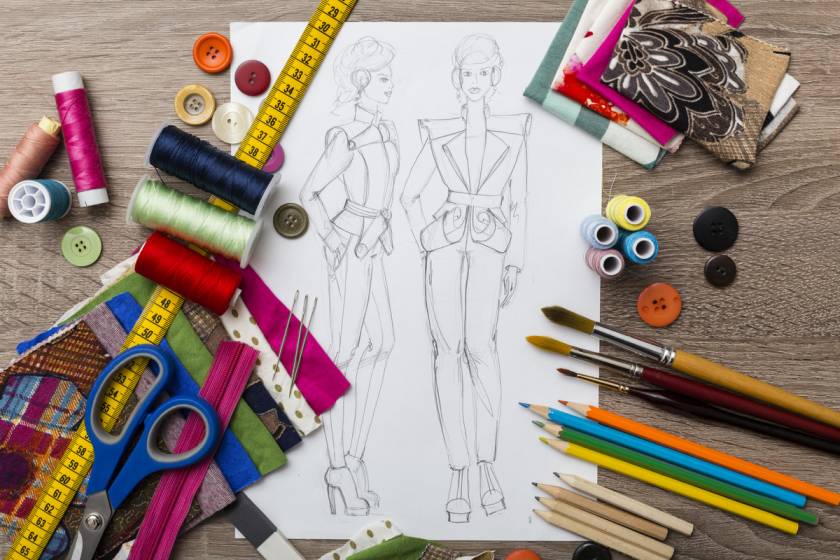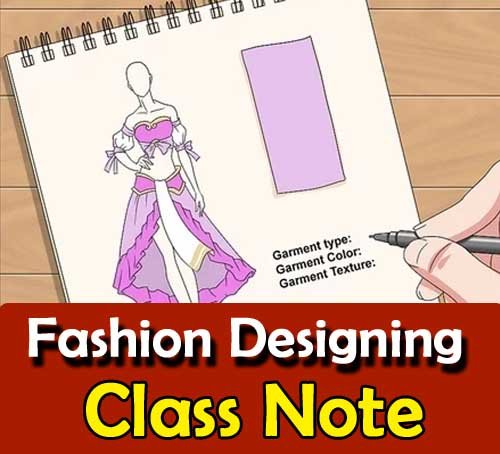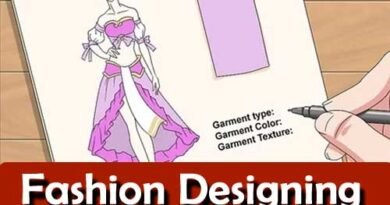Fashion Designing Class Note 40 (Types of Seams)
Fashion Designs Drawings: Types, Techniques, And Examples
In the world of fashion, designers believe in bringing their ideas to life with the help of drawings. A fashion sketch is the first step towards creating beautifully designed garments. Fashion Design Drawings play a vital role in the designing and apparel-making industries. Designers use these drawings to communicate with other people about their ideas. These drawings act as an initial sketch which is later finalized by comparing different colors and patterns.
Types of Fashion Designs Drawings
Fashion Design Drawings are the best friends of a fashion designer. But these drawings have a lot of varieties. Some types of these drawings are-
1. Flat Sketch or Fashion Flat
Flat Sketches are also known as technical flats in the world of fashion. These sketches are linear 2-dimensional black and white illustrations of garments. The sketch is such that as if a garment is laying flat on a surface for display of its designs, stitching, and other detailing. These types of sketches are usually made using software programs.
2. Tech Sketch
Tech Sketch is a flat sketch with details of the particular specifications of the garment in written text. These sketches are also known as callouts. Tech Sketches are mostly used by fashion designers or fashion illustrators to represent a design more precisely with detailed explanations.
3. Spec
Spec or specification is a type of fashion design drawing which is usually used for the manufacturing of apparel. These drawings include a lot of detailing of the garment like the type of fabrics used, the estimated cost of production, etc.
4. Working Drawing
These types of fashion drawings are used by pattern makers. These drawings contain all the specifications needed by the pattern maker to make the pattern pieces like the fabric swatches and fasteners used.
5. Presentation Drawing
Presentation Drawing is the final sketch of the garment which a fashion designer presents to the client or the senior designers.
6. Fashion Croquis
Fashion Croquis is the drawing of the figure of the apparel that can act as a template over which one can design the garment by tracing easily.
Techniques of Fashion Designs Drawings
Fashion drawing is a skill, and can be learned or improved using a lot of techniques. Here are some useful techniques for you to improve your fashion drawing skills.
- Understand Anatomy
To be good at fashion drawing it is vital to know how to draw anatomically correct proportions of a figure. A correct drawn figure allows the garment to look appealing on it. It will be easier for you to draw certain posed figures if you know how to draw them correctly.
- Use Technology
Nowadays, with several advanced technologies in the market, every field is growing at a super-fast pace. In the fashion industry also there is a lot of software that can help you in beautifying your designs and illustrations. For example, a background of a lane or runway can be added while representing a design to the clients. This can give more clarity to the design idea like where it can be worn.
- Make Patterns
Patterns can also tell a story on their own. They can make a simple fabric very interesting. Patterns are never going out of fashion. To design various beautiful fashion drawings try to add some touch of appealing patterns to it.
- Hairstyles matter too
With the figure shape and dress design, the hair of the figure also matters a lot. Learn how to illustrate different hairstyles based on hair textures and thickness. A figure can look more classy if an ideal hairstyle is illustrated with it.
- Focus on the accessories too
In the fashion world, not even a small detailing is left out. Then how can we be careless with the accessories? Accessories also play a vital role in a figure representation of a garment. Choose the accessories wisely. The final look of your drawing should tell a story. Design it carefully and beautifully.
Examples of Fashion Design Drawings
Here are some examples for your reference. When we need a reference what’s better than the best? Here we have some amazing fashion designs by some of the best fashion designers.
Christian Dior
Christian Dior does not need any introduction. He is no doubt one of the best fashion designers in the world. Dior is famous for designing dresses with flared-up waists. Take a look at this design by him.
Christian Bérard
Famous for his unique fashion model drawings Christian Bérard is no doubt one of the best designers the fashion world has seen. His designs illuminate simplicity. One of the features of his fashion drawings is that he uses watercolors and curves in them. Curious? Have a look at one of his masterpieces.
Monique Lhuillier
Monique Lhuillier is a fashion designer famous for his red carpet gowns. Her designs are eye-catching and alluring. Her drawings usually show shadows and three-dimensional detailing. Here is a fashion drawing by her.
Elie Saab
Elie Saab is famous for his evening gowns and bridal wear. His designs are a fusion of western and eastern cultures. His sketches usually have gradients to show the volume of the fabric. Here is a design by him.
Givenchy
Givenchy is a French fashion house, where world-renowned designers like John Galliano work. This fashion house has introduced a lot of iconic designs and trends to the world. Here is a design by Givenchy.
Fabric Surface Embellishment Techniques
Embellishment:
In sewing and crafts an embellishment is the action of adding anything decorative items through the use of the visual arts.
Fabric surface embellishment:
Fabric embellishments are the ornamentation that is normally added to fabrics to make them more beautiful and gorgeous, because of the nature of decorative patterns, which they create. Different kinds of surface design techniques are used for embellishing the fabric. Most common materials that can be used for this process include fringe, boutiques, beads, and buttons.
Different Embellishing Techniques:
Surface embellishment:
Surface embellishment is an important component of free form; it is a great way of bringing your personality, style and skills to your work and putting your own stamp on your project. There are 1000’s of ways to embellish fabrics, garments and any other items.
Textile embellishment:
Textile embellishment can take many forms, with pattern work following the suggestion of nature, the geometrical abstract, fonts and lettering. It can be perceived as a subtlety, the changing of color, line and texture, or it can be much bolder, using large-scale shapes and patterns. Whatever the technique or suggestion for composition, the end result is always nearly the same, to make something more than it was, to add decoration to enhance its attraction to the individual.
Embellishment in decorative arts:
Embellishment techniques are not only applied on the surface of fabrics and textiles, it is also applied to any kind of decorative item. Ceramics, glass, metal, wood in fact all the major and minor decorative arts, used embellishment, as a legitimate tool in which to decoratively enhance their results.
Types of fabric embellishment techniques in sewing and crafts:
Here I will mention the types of embellishment methods that are used to decorate surface design on fabric or garments.
- Embroidery
- Quilting
- Appliqué
- Patchwork
- Trimming (Fringe trim, Sewing trim)
- Lacework (either pre-made or home-made)
- Piping (made from either self-fabric, contrast fabric, or a simply a cord.)
- Beads
- Batik
- Smocking
Some other embellishment items that are used on garments for enrich beauty. For example:
- Buttons
- Zippers
- Buckles
- Grommets
- Sequins
In addition to the multitude of construction and finishing techniques used, the fabric can also be worked upon or embellished in a variety of ways to enhance its surface. Most embellishing methods, such as embroidery, quilting, applique and bead-work are age-old techniques of decorating fabric and are still largely executed by hand. A specialized industrial sector in trimmings, lacework, embroidery and other embellishments has also developed that uses innovative technology to recreate the hand-worked effects on an industrial scale and pace.
Techniques of Embellishing on Garments:
A few fabric surface embellishment techniques are briefly discussed in below:
Embroidery:
Embellishing fabrics with stitches in yarn or thread, using a needle, is one of the oldest forms of art. While the library of embroidery includes hundreds of varieties of stitches, they can be categorized broadly into four main techniques – raised work or stump-work where raised effects are created by stitching over pads of wool and cotton; couched work – creating a pattern with cords by sewing them onto the base fabric; fl at running and filling stitches of which there are hundreds; and counted thread embroidery, e.g. needlepoint and cross stitch, where the stitches are placed over a counted number of threads of the base fabric. Schiffli embroidery is an example of machine embroidery made on the ‘Schiffli’ machine that works sideways with a thousand needles. This machine embroidery with a top, decorative and a back, binding yarn, and is used for making laces and sheer curtain fabrics. Many embroidery stitches can now be produced in digitized embroidery machines which, for large scale production, have multiple heads to produce a number of identical designs simultaneously using an embroidery software program.
Quilting:
Quilting is the technique of Embellishing fabrics stitching together, by hand or machine, multiple layers of fabric with a filling of cotton, foam or polyester batting in between the layers. Quilting is widely used for making bedspreads, quilts, comforters etc. Single-needle, hand-guided quilting machines are used for making outline quilting, where the stitching lines follow the outlines of the print design, vermicelli, which uses free motion all-over stitching patterns, and trapunto or Italian quilting, a form of ‘couching’ where a cord inserted and stitched between the fabric layers creates a raised pattern. In mass-scale automated production, multiple-needle machine quilting is used to make simple geometric patterns. In stitch-less quilting, multiple layers of fabric are fused together thermally or by an adhesive, creating the appearance of being stitched.
Applique: In applique, small pieces of fabric or other material are couched or stitched onto a base fabric. In reverse appliqué, the base fabric is on top of the stitched fabric and the top fabric is cut out to reveal the appliqued fabric underneath.
Patchwork:
Patchwork, used mostly for making bed quilts and cushions, is the technique of creating a fabric layer by joining small pieces of fabric (traditionally scraps of old clothes or textiles) in geometric or abstract patterns. Being a hand-worked technique, it is mostly produced on a small scale.
Trimming: Two types of trimming are most popularly applied on fabric or garments for decoration. Such as:
- Fringe trim:Fringe is an ornamental textile trim, applied to an edge of an item, such as drapery, dress ends, a flag, epaulettes, or decorative tassel, etc.
- Sewing trim:sewing Trim or trimming in clothing and home decorating is applied to ornament or Embellishing fabrics such as gimp, ribbon, ruffles, button, bias tape, etc.
Lacework: Lace is an openwork fabric, patterned with open holes in the work, made by machine or by hand. Lace is another Embellishing item on fabric. It is the very common and ancient craft to embellish fabrics.
Piping: Piping is a type of trim or embellishment, which is used to embellish fabrics for making different style lines. Usually the fabric strip is cut on the bias, and often it is folded over a cord. It may be made from either self-fabric (the same fabric as the object to be ornamented) or contrasting fabric, or of leather.
Beads:
Beads are other types of embellishment. Beadwork is made by needle and thread to stitch beads to Embellishing fabrics, suede, or leather.
Batik:
Batik is a cloth that is traditionally made using a manual wax-resist dyeing technique. For Embellishing fabrics batik is the very popular embellishment technique.
Smocking work:
Smocking is an embroidery technique, used to gather fabric so that it can stretch. Before elastic, smocking was commonly used in cuffs, bodices, and necklines in garments, where buttons were undesirable.
TYPES OF INDIAN SURFACE WORKS, EMBROIDERY AND EMBELLISHMENTS
From zari to chikan, traditional Indian embroidery and embellishments are used to create a contemporary, new story in this modern era. Discover the different types of Indian surface works like embroidery, appliqué & embellishments – precious things that seem to be from another time.
Hey gorgeous! Surface embellishments are an important factor to make your garment more appealing, isn’t it? Western culture had great influences on Indian clothing, but traditional surface works always held a place of pride for Indians. Specific types of Indian surface works not only represent their traditions but also their significance. They tell the stories of their communities with a choice of colors, motifs, stitches, and textiles used.
Last year, I learned about many of these types of Indian surface works from artisans in Kutch, Gujarat. I personally made a few samples and the experience was quite time-consuming just to get one proper patch of embroidery. The amount of detail and work that goes into making these samples is quite painstaking. In fact, I have always been fascinated by Indian surface works and their techniques.
Types of Indian Surface Works
Let us take a look at various types of Indian surface works that are beautiful and mind-blowing – from Gujarat to West Bengal, from Karnataka to Kashmir.
1. Rogan Art Rogan is an ancient textile oil art and a rare craft of India, only made by the Khatri family of Nirona Village, Kutch, Gujarat. Originating in Persia, it came to Kutch around 300 years ago. In Persia, Rogan means oil. The paint has been made into a thick substance with the help of castor oil.
Rogan art is the type of Indian surface works done with vibrant natural colors and twisted motifs with a blunt needle that never comes in contact with the cloth. Traditionally, it was used to beautify the bridal clothing of the regional tribes. Nowadays, it is used in many products like sarees, dresses, jackets, wall pieces, handbags, and many more.


